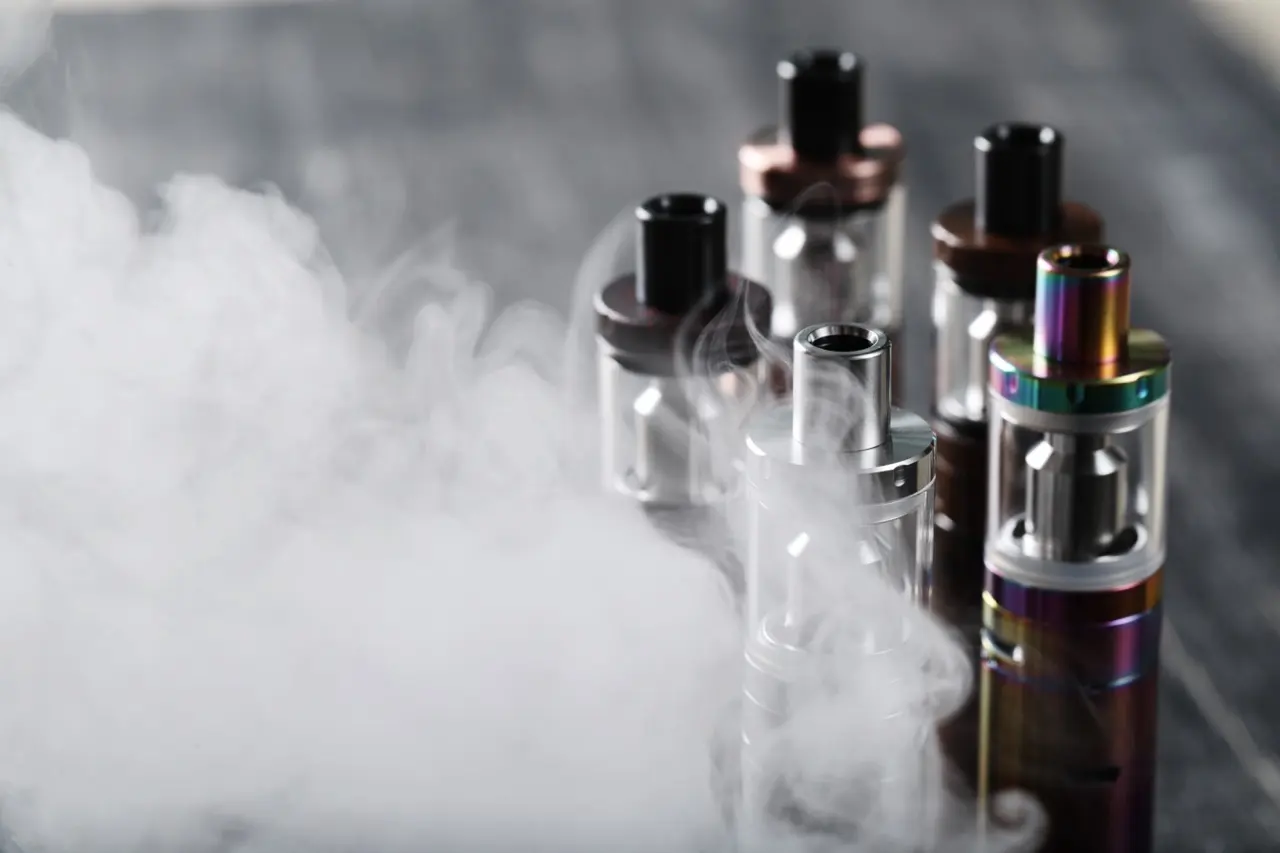
Vaping in Teens: Lung Cancer Awareness Month
Teen vaping can lead to addiction and severe health issues like lung disease.
It’s estimated that 1 in 5 high school teens and 1 in 20 middle school teens have vaped in the past month. In fact, from 2017 to 2019, teen vape use doubled, then decreased during the pandemic as teens stayed home from school. Now that teens have returned to school, the opportunities for vaping increase as teens gather socially.
Parents don’t often realize that their teen uses e-cigarettes or other vape devices. Coupled with teens being notorious for secretive behavior and following the crowd, the opportunity to have a conversation about vaping can easily fall by the wayside.
Most teens and their parents may not know that vaping can damage young lungs, especially if they vape cannabis. Cannabis increases teen and young adult risk for lung injury. There is even a name for it: e-cigarette or vaping use-associated lung injury (EVALI).
Over 2800 e-cigarette users developed EVALI, requiring hospital admission (through February 2020). Teens and young adults made up most of those admissions – 68 died.
If vaping isn’t on the radar at home, it’s time for families to have a serious conversation about it and addiction. November being Lung Cancer Awareness Month creates an excellent segue to the subject.
Vaping in Teens
Lung Cancer Awareness Month
Teen vaping can lead to addiction and severe health issues like lung disease.
It’s estimated that 1 in 5 high school teens and 1 in 20 middle school teens have vaped in the past month. In fact, from 2017 to 2019, teen vape use doubled, then decreased during the pandemic as teens stayed home from school. Now that teens have returned to school, the opportunities for vaping increase as teens gather socially.
Parents don’t often realize that their teen uses e-cigarettes or other vape devices. Coupled with teens being notorious for secretive behavior and following the crowd, the opportunity to have a conversation about vaping can easily fall by the wayside.
Most teens and their parents may not know that vaping can damage young lungs, especially if they vape cannabis. Cannabis increases teen and young adult risk for lung injury. There is even a name for it: e-cigarette or vaping use-associated lung injury (EVALI).
Over 2800 e-cigarette users developed EVALI, requiring hospital admission (through February 2020). Teens and young adults made up most of those admissions – 68 died.
If vaping isn’t on the radar at home, it’s time for families to have a serious conversation about it and addiction. November being Lung Cancer Awareness Month creates an excellent segue to the subject.
What Exactly is Vaping?
Some people define vaping as drug abuse. Vaping is widely viewed as a gateway to addiction since nicotine and marijuana are easily used within vape devices.
Think of how someone with asthma uses a nebulizer to breathe in the medicinal vapor. Vaping is very similar. Both create a cloud of vapor that is inhaled and exhaled. While nebulizers open air passages for better breathing, studies have shown that vaping can damage lung tissue over time.
Although many people consider e-cigarettes and vaping to be the same thing, they aren’t. E-cigarettes look similar to traditional cigarettes, while vaporizers, commonly called vapes, can be user-modified and come in many shapes and sizes.
Parts of an e-Cigarette
- A rechargeable lithium-ion battery A vaporizing chamber A "vape juice" cartridge
- A vaporizing chamber
- A "vape juice" cartridge
These handheld devices create aerosol emissions similar to second-hand smoke that can be breathed in by others. The aerosol emissions may also fall onto surfaces or mix with dust that can irritate the lungs and skin. Most contain nicotine, flavored chemicals, or other additives like cannabis, methamphetamines, or opioids.
Parts of a Vape
- Battery
- Heating element
- Chamber
- Cartridge
- Mouthpiece
Both e-cigarettes and vapes work by heating the selected liquid or organic substance so that they can inhale it through a cloud of vapor.
The e-Cigarette and Vape Market
Vaping is over an $18 billion dollar industry worldwide and is expected to grow by nearly 30 percent in the U.S. alone by 2030. With an estimated compound annual growth rate (CAGR) hitting nearly $183 billion, teens are a prime target for market efforts by 2030. Many will be adults who use e-cigarettes or vape, raising a new generation of potential vape consumers.
JUUL Labs, the most popular e-cigarette maker with teens, has discontinued most of its marketing to teens and most of its flavors. The company appealed, but the FDA stayed the marketing order on July 5, 2022. How this will affect the available vape products to teens has yet to be determined.

The Four Generations of Vape Products
Smokeless cigarette products were first patented in the 1930s but were never introduced to the public. It wasn’t until the 1963 debut of the first smokeless, non-tobacco prototype that it evolved into the first-generation vaporizer around 2007. Currently, there are four generations of vape products on the market today.
Generation One: Cig-A-Likes
Cig-A-Likes look like traditionally lit cigarettes. They come in disposable or rechargeable, but not refillable, styles. Known as the “gateway to vaping,” cig-a-likes are inexpensive and easy for teens to find as they are readily available at gas stations and convenience stores. Flavors tend to be limited, but the nicotine content can rival a pack or two of conventional cigarettes.
Most beginners start with cig-a-likes. There’s no real commitment, making them a prime start for teens wanting to try vaping for the first time.
Generation Two: Vape Pens
Vape pens are larger than cig-a-likes. They are different as they are manually operated, meaning that a push button operates the heating element.
Generation Three: Box Mods
Box mods have a larger capacity than vape pens. They aren’t as easy to conceal as vape pens. They are also customizable.
Generation Four: Pod Mods
Pod mods are larger, eminently customizable, and more expensive than box mods. As with box mods, pod mods are not easily concealed. Most also have to be assembled before use.
Why is Vaping So Popular with Teens?
Most vapes are inconspicuous and easy to hide. Teens are drawn to the many flavors, often gleaning an enjoyable head rush. Vaping connects teens and is seen as cool, harmless, and fun. Teens compete with each other in cloud competitions and vape tricks, where they exhale vapor in shapes and patterns through their ears, eyes, or nose.
Teens often start vaping out of curiosity after seeing family or friends vape. Many vape due to peer pressure. Teens live in a world of instance, of immediate gratification.
Vaping is easily dismissed as harmless if they don’t see a health risk. The fact is that vape ingredients can be addictive, harming lungs and changing brain chemistry in young brains that aren’t fully developed until around age 25.

Health Risks Associated with Vaping
Vape chemicals are known to harm lung health. Vape clouds aren’t simply harmless clouds of water vapor. Teens are exposed to varying degrees of nicotine and heavy metals such as tin, lead, and nickel.
- EVALI
- Lung cancer
- Heart arrhythmias
- Anxiety and depression
EVALI
Knowing precisely what causes EVALI (e-cigarette or vaping product use associated lung injury) isn’t easy as there’s no simple test to diagnose it. What is known is that EVALI is an inflammatory response in the lungs triggered by inhaled vaping substances. Right now, EVALI is a diagnosis of exclusion. If there are respiratory symptoms, recent vape use, and lung scan issues but no infection, doctors may diagnose EVALI.
EVALI can present as pneumonia, inflammation, or damage to the lung’s air sacs (alveoli). Another diagnostic issue is that vaping uses many different ingredients, often illicit. Everyone who vapes also has a unique biological makeup, so some people will get EVALI, and others won’t. Doctors don’t know why but agree that THC and Vitamin E acetate increase lung injury risk.
Lung Cancer
Vaping introduces many chemicals and ultrafine particles into the lungs. Scarring and obstructions in the lungs, also called popcorn lung, have been linked to the chemical diacetyl. Science hasn’t determined that vaping directly causes lung cancer, but the chemicals that vaping introduces into the lungs, like diacetyl and formaldehyde, are known, cancer-causing agents.
Lung cancer risk is the leading cause of concern among parents, even though it is still not proven to cause it, according to the national cancer institute it is uncertain what the repercussions vaping will have on today’s youth. Vaping is still considered a risk factor when talking about lung cancer, and who knows it may be later discovered that it is a leading cause of this disease.
Heart Arrhythmias
In a study released on November 15, 2022, scientists found that e-cigarettes and vaping can cause increased vulnerability to heart arrhythmias. Heart arrhythmias include various forms of irregular heartbeat. The study concluded that vape inhalation interfered with the heart’s electrical impulses, structure, and neural regulation.
Anxiety and Depression
Teens often turn to vaping when anxious or feeling depressed. Many teens reach for their vape to cope with these feelings. Scientists have found a strong link between vaping and depression, especially among older teens who vape often.
Signs of Teen Vaping
Parents that suspect their teen is vaping can look for warning signs such as new behaviors, changes in school performance, and unusual breathing issues.
- Equipment such as new chargers and small tools for marijuana vaping.
- Online purchases parents don't authorize and an unusual amount of deliveries to teens.
- Fruity or skunk-like scents that don't belong. Marijuana vaping smells like skunk, and flavorings tend to be fruity.
- Nosebleeds from inhaling and exhaling through the nose.
- Bloodshot eyes, wheezing, and dry coughs as vapor affect eyes, lungs, and throat.
- Unusual secretiveness as teens tries to hide their vaping.
- Lack of concentration and working memory as the brain is affected.
- Anger and physical aggression if a teen is going through vape withdrawal.
- Allergic reactions to flavorings or nicotine include chest pain, swelling, and itchy skin, or throat.
- Use of vape slang in calls, social media, and text messages.
This is not an all-inclusive list of vaping signs, as families and their environments are unique.
Vape Lingo
Teens who use e-cigarettes or various vaping devices often use vape lingo with their friends. Here are a few examples that parents may pick up on when listening in to their teen’s conversations with other teens:
- Atty: an atomizer
- Clone: a knock-off of an original vape device that's inexpensive
- Clouds: the vapor that is breathed in during vaping
- Fiending: someone seeking nicotine all the time
- Ghost: a long vape pull that is not exhaled for as long as the user can hold it to show how tough they are
- Greening: vomiting after hitting THC
- Hit: a vape puff - also called dab, drag, JUUL, tax or ripski
- Nicked: high nicotine euphoria
- Nic Sick: heart palpitations, lightheadedness, nausea, and vomiting due to nicotine overuse
- Rip it: vaping as much as can be tolerated by the user
- Throat hit: the "kick" or tingling sensation of nicotine in the back of the throat
- Sauce: e-juice
- Stealth Mode (Zero): the user attempts to hide their vape usage by holding in inhaled vapor
There are many other popular words and phrases associated with vaping. Before starting that initial conversation with a teen, it is essential to become familiar with vape jargon and products.
How to Speak to Teens about Vaping
Finding the right moment to talk to teens about vaping and its consequences is difficult. Some teens prefer texting, and others prefer face-to-face discussions. Finding a natural way to bring up e-cigarettes and vaping will increase teens’ odds of listening. Lecturing teens often causes them to shut down the conversation.
Before beginning any conversation with teens, know the lingo, know the facts about vaping. Don’t try to have a conversation when stressed. Conversations don’t have to answer questions all at once. Some conversations are best left to happen over time, in bits and pieces, as the opportunities present themselves.
So keep the dialogue open and non-critical. Seeing someone use an e-cigarette, an advertisement or billboard, or passing by a shop are all excellent transitions into an organic conversation. However, some teens feel better talking to someone other than their parents. Suggest that they speak to a trusted friend, a school counselor, a coach, a faith leader, or a teacher to reinforce a conversation that has already started.
Getting an idea about a teen’s volume of vaping, how often they vape, what kind of vape product they prefer, how many hits they take at one time, or how long it takes them to go through a cartridge can give parents a clear picture of what kind and how much vaping teens are exposed to.
Be the example. Parents who use tobacco are more likely to have teens experiment with tobacco products, including e-cigarettes and vaping. It’s never too late to quit vaping.

November is Lung Cancer Awareness Month
Nicotine has long been shown to increase the risk of cancer, heart disease, stroke, lung diseases, diabetes, and chronic obstructive pulmonary disease (COPD). Since most teens vape using nicotine-containing products, the dangers of lung disease increase. November is Lung Cancer Awareness Month. It’s an excellent opportunity for families to open up conversations about vaping and its consequences.
Southern California Sunrise Recovery Center can help families facing issues with teen vaping and drug addiction. Early diagnosis can make the treatment more effective. If you are a smoker or know someone who is abusing substances or is showing symptoms of addiction, we recommend that professional treatment is sought.
Sources
“E-Cigarette Chemicals May Harm Lung Health.” Harvard T.H. Chan School of Public Health, 1 Feb. 2019, www.hsph.harvard.edu/news/press-releases/common-e-cigarette-chemical-flavorings-may-impair-lung-function.
“E-Cigarettes and Vape Pens Generations, the Tobacco Prevention Toolkit.” Council on Recovery, 3 Nov. 2019, www.councilonrecovery.org/wp-content/uploads/2019/11/03-E-Cigarettes-and-Vape-Pen-Generations-Factsheet-1.pdf.
“E-Cigarette, or Vaping, Products Visual Dictionary.” Centers for Disease Control and Prevention, www.cdc.gov/tobacco/basic_information/e-cigarettes/pdfs/ecigarette-or-vaping-products-visual-dictionary-508.pdf.
“FDA Denies Authorization to Market JUUL Products.” U.S. Food And Drug Administration, 23 June 2022, www.fda.gov/news-events/press-announcements/fda-denies-authorization-market-juul-products.
“The Flavor Trap: How Tobacco Companies Are Luring Kids With Candy-Flavored E-Cigarettes and Cigars, an Executive Summary.” Campaign for Tobacco Free Kids, 15 Mar. 2017, www.tobaccofreekids.org/microsites/flavortrap/executive_summary.pdf.
Glantz S, Jeffers A, Winickoff JP. Nicotine Addiction and Intensity of e-Cigarette Use by Adolescents in the US, 2014 to 2021. JAMA Netw Open. 2022;5(11):e2240671. doi:10.1001/jamanetworkopen.2022.40671
Qiu, H., Zhang, H., Han, D. D., Derakhshandeh, R., Wang, X., Goyal, N., Navabzadeh, M., Rao, P., Wilson, E. E., Mohammadi, L., Olgin, J. E., & Springer, M. L. (2022). Increased vulnerability to atrial and ventricular arrhythmias caused by different types of inhaled tobacco or marijuana products. Heart Rhythm. https://doi.org/10.1016/j.hrthm.2022.09.021
“Quick Facts on the Risks of E-cigarettes for Kids, Teens, and Young Adults.” Centers for Disease Control and Prevention, www.cdc.gov/tobacco/basic_information/e-cigarettes/Quick-Facts-on-the-Risks-of-E-cigarettes-for-Kids-Teens-and-Young-Adults.html.
“Vaping Lingo Dictionary.” The Truth Initiative, June 2020, truthinitiative.org/sites/default/files/media/files/2020/06/Truth_Vaping_Lingo_Dictionary_FINAL.pdf.
Wein, Harrison, editor. “Vaping Rises Among Teens.” National Institutes on Health News in Health Newsletter, Feb. 2019, newsinhealth.nih.gov/2019/02/vaping-rises-among-teens.
Clinically Reviewed By
Dawn Masick, LMFT
Dawn has experience dealing with various relational, emotional, and psychological struggles. Dawn’s training has prepared her to work with children, teens, young adults, adults, couples, and families. She has undergone training in DBT, TF-CBT, and Family Therapy. Other competencies include dealing with ADHD, mood/anxiety disorders, parenting challenges, addiction, PTSD, co- dependency, and relationship issues. I have experience in residential, school-based mental health, children’s community mental health, victims of crime (VOC), and private practice settings.
Dawn has been committed to guiding clients through their trauma, coming alongside them in their healing, and supporting them as they navigate life changes. Dawn’s passion is working with clients struggling with trauma in substance abuse and mental health.


